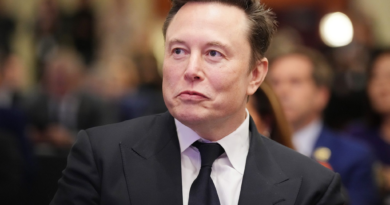For Dell, 3 factors explain why transparency is key to its sustainability efforts
Cassandra Garber, chief sustainability officer of Dell Technologies, likes things in threes. Fittingly, she thinks three factors explain why for businesses, sustainability, and the disclosure that goes with it, are vital for building trust.
First, stakeholders’ demand for transparency on environmental and social topics has been growing for some time, Garber tells me. “Even if they’re not in agreement or alignment with what you’re doing, they want you to be transparent about it.”
The second big factor is regulation. “Transparency on greenhouse gas emissions in particular is now regulated in multiple countries and, increasingly, in several states,” Garber says. “So data transparency in general on environmental and social issues is becoming a compliance topic.”
The third? AI—which is both a problem and a solution. “Transparency of our data in this space, not only is it more critical because of the environmental and social impacts of AI and risks associated with AI, but AI makes transparently sharing data easier.”
At global tech giant Dell, Garber leads an ambitious ESG effort that spans climate, the circular economy, digital inclusion, human rights, and philanthropy. “Our strategy, in a nutshell, is integrate sustainability everywhere.”
To do that, Dell runs a hub-and-spoke model, Garber notes. “My team is the hub, and so we sit at the center of the company,” she says. “Anything pan-Dell that is environmental or social impact, we run, we coordinate, we facilitate.”
Garber’s team also uses a little something called OMG, or Operating Model and Governance. Every business unit and function in the 120,000-employee company has a responsible ESG lead who is part of its ESG Interlock community.
This a business imperative, not a nice-to-have. “We identify what are the environmental and social risks and opportunities within your business unit and/or your function,” Garber says. “You are responsible for prioritizing what actions you are going to take, what deliverables you have on your plate, in alignment with our overall strategy for the company.”
The internal conversations that result help move the needle. “That’s how we get scale, and that’s how we get a catalyst,” Garber says.
She gives the example of projected emissions. “We have this network where we can immediately go out to everyone and say, ‘Hey, flagging this is happening. Need help from CSG [Client Solutions Group] and finance to figure out how we’re going to tackle this,’” Garber explains. “Our internal operating model is the key to our transparency.”
To be transparent with customers, Dell provides the carbon footprint for the product configuration they’ve chosen. “There is no standard for the IT industry for a product carbon footprint, so transparency becomes the key,” Garber says. “What is included in your carbon footprint becomes critical to explaining what the number is, because you can’t assume all product carbon footprint methodologies are the same.”
Dell also shares its nine ESG goals. Among them: By 2050, it will achieve net-zero GHG emissions across scopes 1, 2, and 3. That goal is approved by the Science Based Targets Initiative (SBTi).
Which brings us back to AI.
For Garber, generative AI is a perfect example of how a fundamental industry shift can knock sustainability goals off course. “And everyone in your industry is immediately off track because the energy required to run these large language models is significant.”
Dell has a strategy to confront the AI challenge. For starters, it can make its products more energy-efficient, Garber says. “It’s also an operating strategy, because we can use AI to do a better job of managing energy efficiency, of finding electricity and renewable electricity.”
But ultimately, it’s all about transparency, Garber maintains. “If we recognize that we are not going to meet the goal—which many of us in the industry are openly talking about—transparency is the epitome of how you explain that to regulators and to customers.”
Such frankness can be a trust builder. “For us, it’s about showing the impacts of AI, showing how we’re addressing them,” Garber says, “showing what impact that has on our goals and what we’re doing as an industry to do our best to stay on track.”
Three cheers to that.
Nick Rockel
nick.rockel@consultant.fortune.com
IN OTHER NEWS
Hedging his bets
Ken Griffin doesn’t trust that President-elect Donald Trump’s proposed tariffs will be good for business. Calling himself “very anxious” about tariffs being used in trade policy, the hedge fund billionaire said they could be profitable for now but end up hurting U.S. companies’ global competitiveness. However, Griffin also argued that under Trump, businesses will escape regulatory overreach—freeing them to “return” to creating jobs and boosting the economy. Either way, you’ll be just fine, Ken.
Money for nothing
Luxury brands clearly need to win back shoppers’ trust. A whopping 50 million consumers have stopped buying designer goods from the likes of Burberry and Louis Vuitton, or found themselves priced out of the market, Jane Thier reports. That’s the word from Bain & Company, which forecasts that just a third of luxury brands will finish 2024 with positive growth. The category has broken its promises to consumers, reckons equity analyst Marie Driscoll. “Since 2019, there’s been a high price increase across luxury without a corresponding increase in innovation, service, quality, or appeal that a luxury brand should provide.” Nice try.
Soft spot
When it comes to earning the trust of employers, Gen Z has some catching up to do. Less than half of workers and only about 10% of mid-level executives think entry-level employees are ready to join the workforce, a new survey reveals. Almost one in four of execs polled wouldn’t even hire such people. The main sticking point: lack of soft skills such as communication, collaboration, and adaptability. The workers themselves agree, with 40% of Gen Z respondents owning up. One solution? Better onboarding and training. Don’t be shy.
Duping it out
Wealthier consumers have found a trusted friend in Walmart, of all places. The world’s biggest retailer enjoyed a strong third quarter where about 75% of its share gains came from households pulling down more than $100,000 a year, Sydney Lake writes. Chalk that up to its skill at catering to “dupe” shoppers—those seeking cheaper, but almost identical, versions of costly products. For higher-income folks, snagging such deals at Walmart is now socially acceptable, and even a point of pride. Who doesn’t love a bargain?
TRUST EXERCISE
“Despite the benefits of remote work for employees, many organizations are abandoning it in favor of returning to the office full-time–or part-time in a hybrid model. A 2024 survey from BetterUp shows that the number of primarily remote roles has been cut in half–and one out of four organizations cite improved connection and culture as the business rationale behind mandated office returns.
However, our research found that returning to an office often is a major disruption to one’s routine, foundational work, and overall life experience. We surveyed 1,400 full-time U.S. employees who were mandated to return to in-office work and found that they had higher burnout, stress, and turnover intentions. They also had lower trust in their organization, engagement, and productivity levels. Our results indicate that if the return-to-office transition is not handled with a high level of humanity, sensitivity, and empathy, workplace culture suffers, and the workforce’s sense of belonging plummets.”
For many workers, RTO has turned out be a bummer that also erodes trust in their employer. Along with Erin Eatough—co-founder of HR consultancy Fractional Insights—Christine Carter, Kristi Leimgruber, and Khoa Le Nguyen of coaching platform BetterUp don’t pull any punches as they lay out the potential downsides.
Although people form better working relationships in real life, the quartet notes, poorly handled RTO mandates breed employee resentment. Even a brief commute is linked to greater stress and anger, and returning to the office robs people of the flexibility to knock off small household tasks during the workday. Then there’s the sticker shock: an average of $561 in extra monthly costs, the equivalent of a two-person household’s grocery bill.
Thankfully, Carter, Eatough, Leimgruber, and Nguyen also offer some coping mechanisms.
They suggest that employees try to maximize the benefits of RTO—for example, by building stronger ties with colleagues. For anyone called back to the office full-time, it’s a chance to leave work at work too, or to build healthy habits like a gym visit into their day. Employees can also ask for what they need to make RTO work better, whether it’s a late start or extra gas money. Here’s to many happier returns.




